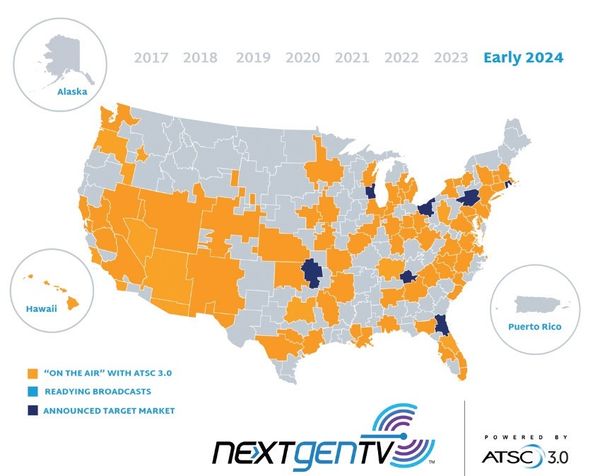Updated 1/23/2025: ATSC 3.0 Deployments: Where and When Will NextGen TV be Available?
NextGen TV broadcasts now available in 75+ markets

UPDATED 1/23/2025: According to the ATSC, as of October 2024, 76% of the United States is within reach of an ATSC 3.0/NextGen TV signal.
Pearl TV recently estimated that more than 14 million NextGen TV capable devices will have shipped by the end of 2024.
The Consumer Technology Association estimates that 120 million NextGen TV sets will be sold by 2024. The ATSC says that more than 100 NextGen TV-capable products will be available to consumers in 2025.
There are now approximately 75 models available at retail, at a starting price point between $600 and $700, from Sony, Samsung, Hisense, TCL, RCA and Panasonic. For more information, visit watchnextgentv.com.
TV Tech sister brand Tom's Guide has a list of recommended sets.
Here is a complete list of the ATSC 3.0 deployment breakdown:
“On the Air” With ATSC 3.0
- Albuquerque-Santa Fe, N.M.
- Albany, N.Y.
- Atlanta
- Austin, Texas
- Baltimore
- Birmingham, Ala.
- Boise, Idaho
- Boston
- Buffalo, N.Y.
- Champaign & Springfield-Decatur , Ill.
- Charlotte, N.C.
- Charleston S.C.
- Chicago, Ill.
- Cincinnati, Ohio
- Columbus, Ohio
- Cookeville, Tenn.
- Dallas-Forth Worth, Texas
- Dayton, Ohio
- Denver
- De Moines, Iowa
- Detroit
- East Lansing, Mich.
- El Paso, Texas
- Flint, Mich.
- Fresno-Visalia, Calif.
- Green Bay, Wisc.
- Greensboro, N.C.
- Greenville-Spartanburg-Asheville-Anderson S.C.
- Grand Rapids-Kalamazoo, Mich.
- Harrisburg, Pa.
- Hartford, Conn.
- Houston
- Indianapolis
- Kansas City
- Las Vegas
- Louisville, Ky.
- Little Rock-Pine Bluff, Ark.
- Los Angeles
- Miami, Fla.
- Minneapolis, Minn.
- Mobile, Ala.-Pensacola, Fla.
- Myrtle Beach-Florence, S.C.
- Nashville, Tenn.
- New Orleans
- New York City
- Norfolk-Portsmith-Newport News, Va.
- Oklahoma City
- Omaha
- Orlando-Daytona Beach-Melbourne, Fla.
- Philadelphia
- Phoenix
- Pittsburgh
- Portland, Maine
- Portland, Ore.
- Raleigh-Durham, N.C.
- Richmond-Petersburg, Va.
- Roanoke-Lynchburg, Va.
- Rochester, N.Y.
- Sacramento-Stockton-Modesto, Calif.
- Salt Lake City
- San Antonio
- San Diego
- San Francisco
- Santa Barbara-Santa Marie-San Luis Obispo, Calif.
- Seattle-Tacoma
- Shreveport, La.
- South Bend, Ind.
- Springfield, Mo.
- Springfield-Holyoke, Mass.
- St. Louis, Mo.
- Syracuse, N.Y.
- Tallahassee, Fla.
- Tampa-St. Petersburg-Sarasota, Fla.
- Tucson, Ariz.
- Twin Falls, Idaho
- Washington D.C.
- West Palm Beach, Fla.
- Wichita-Hutchinson
First Markets
- Burlington, Vt.-Plattsburgh, N.Y.
- Chattanooga, Tenn.
- Chicago
- Cleveland-Akron, Ohio
- Davenport, Iowa-Rock Island-Moline, Ill.
- Asheville, N.C.
- Memphis, Tenn.
- Providence, R.I.-New Bedford, Mass.
While the markets will be capable of broadcasting these signals, there is still a need for consumer devices to receive them. However, there are efforts by major manufacturers and Kickstarters alike, to make that technology available.
The professional video industry's #1 source for news, trends and product and tech information. Sign up below.
